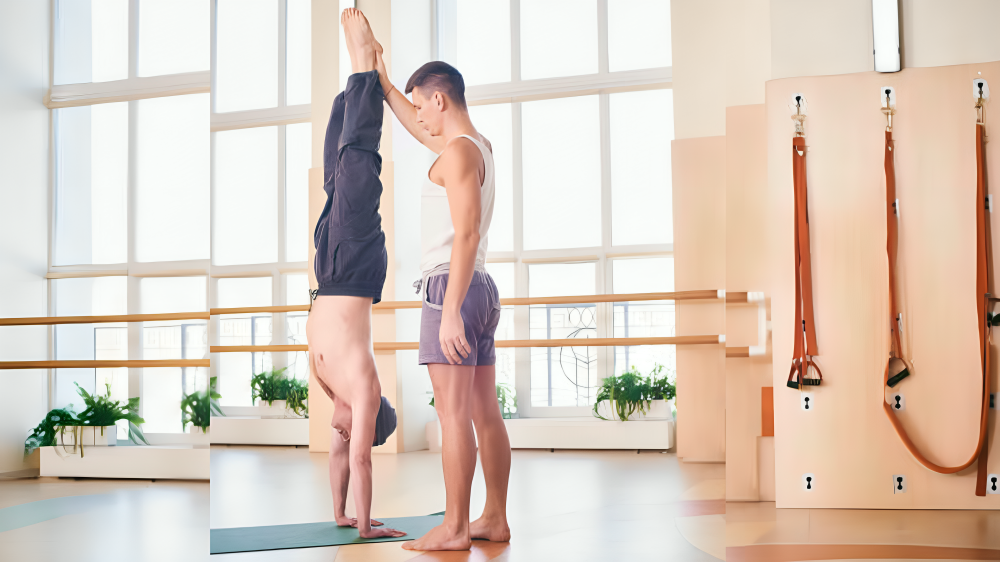
What is Adho Mukha Vrksasana?
Adho Mukha Vrksasana translates from Sanskrit to mean “Downward-Facing Tree Pose.” More generally referred to as a Handstand. This inversion pose requires you to balance your whole body on your hands with the feet lifted towards the sky while mimicking a tree standing on its “roots.
How to Do Adho Mukha Vrksasana (Handstand)
Warm-Up Your Body
Start off by doing some preliminary work to get warmed up before assuming any difficult pose. More importantly, Handstand is an inversion that requires some kind of pre-heating of the wrists, shoulders, core, and legs. A few rounds of Sun Salutations can get your body ready or some Downward Dog.
Find Wall Support
If you are new to Handstands, then a wall behind is great to provide you confidence and safety. So stand about a foot away from the wall and place your hands on the floor shoulder-width apart. Spread fingers wide for better grip and stability.
Get into Position
Starting in a standing forward fold, place your palms on the ground and get into a Downward Dog position. Your wrists should be directly under your shoulders. Now, lift one leg up to the ceiling while keeping the other at a bent position.
Kick Up
Now it’s time for the fun part! Kick up the bottom leg while you simultaneously push off with your grounded foot. Work on bringing both legs up toward the wall together. If you do not get up the first time, that is okay-just practice. You will build strength and coordination over time to get your legs up in the air.
Hold the Handstand
Once your feet are up against the wall-or free-standing, if you are advanced-engage your core, extending your legs as you do so. Press your hands into the ground to maintain your body in a strong, straight line; keep your neck long.
Come Down Slowly
When you are ready to come down, lower one leg at a time with control. Rest in Child’s Pose – Balasana for some breaths to release any tension in your arms and back
Benefits of Adho Mukha Vrksasana
Strengthens Upper Body
Adho Mukha Vrksasana is a powerhouse for your arms, shoulders, and chest. Upside down, you hold yourself up; this automatically would mean that your upper body is forced to work hard, hence building serious strength over time.
Improves Core Stability
While performing a Handstand, one always has to engage the core muscles. This will build a strong and stable core, which is very essential not only in yoga but also while standing, walking, or lifting in daily events.
Improves Balance and Coordination
Handstands make you hyper-aware of your body’s positioning in space. It amplifies your balancing and coordinating skills, which is helpful not just on the mat but also in daily life.
Increases Focus and Concentration
Because Handstands are such a tricky pose, they demand complete focus. You can’t be thinking about your grocery list when you’re upside down! This transfers to a mental clarity-enabling you to feel more present and aware in your everyday living.
Boosts Circulation
Inverted, blood flow to the brain and upper body helps improve circulation, giving you a natural energy boost that may even help clear your mind.
Builds Confidence
Let’s face it: nailing a Handstand feels pretty amazing! The journey to mastering this pose builds perseverance, courage, and self-confidence.
It’s Here Pincha Mayurasana how to do it and what are the benefits
FAQs
Q: Can beginners do Adho Mukha Vrksasana?
A: Of course! Beginners can definitely start with the practice of Handstands, especially with the support of a wall. One just needs to have patience and practice regularly.
Q: How often should I practice Handstands?
A: Practice as often as you feel comfortable, but consistency is key. Even a few minutes each day can help you progress.
Q: What if I’m scared to fall?
A: Falling does happen in every learning process. Begin with support from the wall or having a soft mat beneath you. Falling will eventually not seem so terrible, and confidence will build in time

